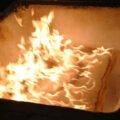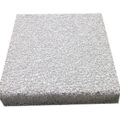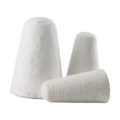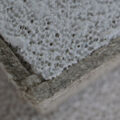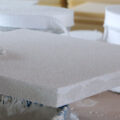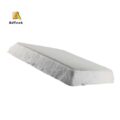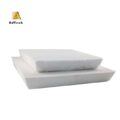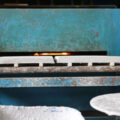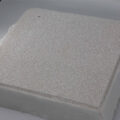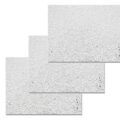The ceramic foam is made of an open-celled, preferably hydrophobic, flexible foam material having a plurality of interconnected voids surrounded by a network of said flexible foam material. Typical materials that can be used include polymer foams, such as polyurethane foams, and cellulose foams. Generally, any combustible organic plastic foam that has elasticity and the ability to restore its original shape can be used. The ceramic foam must be burned or volatilized below the firing temperature of the ceramic material used.

The aqueous ceramic slurry used should be thixotropic, have relatively high fluidity, and consist of an aqueous suspension of ceramics intended for use in the material. Typical ceramic materials that can be used include mixtures of alumina, zirconia and silicon carbide or ceramics. Although alumina is preferred as the refractory material, any refractory material suitable for use with a phosphate binder and having a sintering temperature higher than the volatilization temperature of phosphorus can be used. Although aluminum orthophosphate is the preferred binder, other binders such as phosphoric acid, aluminum phosphate, alkali metal phosphates (such as sodium hexametaphosphate) and the like can be naturally used if necessary. The slurry should contain at least 8%, preferably greater than 10% by solid weight of phosphate binder.
The flexible foam material is impregnated with the aqueous ceramic slurry so that the fibrous web is coated with it and the voids are filled with it. Generally, it is preferable to simply immerse the foam in the slurry for a short enough time to ensure that the foam is completely impregnated.
Then the impregnated foam material is compressed to discharge a part of the slurry, while the fibrous web is partially covered by it and has multiple plugged pores on the entire body to increase the tortuosity of the flow path, that is, evenly distributed in the entire ceramic body Rather than distribute them in groups. together. In continuous operation, the impregnated foam can be passed through preset rolls to achieve ideal discharge of the slurry from the foam and maintain the desired amount of impregnation therein. Naturally, this can be done manually by simply squeezing the flexible foam material to the desired degree. At this stage, the foam is still flexible and, if necessary, can be formed into a structure suitable for the specific filtration task, namely a curved plate, a hollow cylinder, etc. The foam formed must be kept in place by conventional means until the organic substrate. Decompose, or preferably until the ceramic is sintered. The impregnated foam is then dried by any suitable means, such as air drying, accelerated drying at a temperature of 100°C to 700°C for 15 minutes to 6 hours, or by microwave drying. Air drying can be completed within 8 to 24 hours. After drying, the material is heated at an elevated temperature to sinter the ceramic coating on the fibrous mesh, leaving multiple blocked pores as described above.

